Journal of Our Meditation Retreat at Auschwitz-Birkenau
(Auschwitz I and II)
Faith Halter & Ralph Hammelbacher
June, 2010
The immediate origins of our decision to join a Buddhist meditation retreat
at the Auschwitz-Birkenau death camps lay:
| |
First, in Faith's decision about two years ago to begin confronting her terror
about the Holocaust; and
Second, in our trip eighteen months ago to London, to meet Roman and Susie
Halter, both Holocaust survivors. Roman is a cousin from the Polish branch of
Faith's family. He was the only member of his large nuclear family to survive
the war, as well as almost the only member of his extended Polish family to
survive. We discovered Roman's recently published memoir, ordered it online, saw
from the author's bio that he lives in London, found his phone number and
called, received a warm invitation to come visit -- and about a month later, we
spent five days getting to know Roman and Susie. They were so gracious and
welcoming and we were so grateful for the chance to meet them. Roman is the same
age as Faith's father. Their grandfathers were half-brothers; Faith's
great-grandfather emigrated to London in the early 1900s and the two branches of
the family gradually lost contact. |
After our return from London, Faith's friend Jill reminded her of a Buddhist
organization that leads an annual retreat at Auschwitz. Faith had forgotten all
about this; it was many years since she had told Jill about the book that
describes the first of these retreats, Bearing Witness by Bernie Glassman. Six
months after Jill's reminder, in early June, Ralph and Faith were in Poland to
participate in this yearís Bearing Witness retreat for five nights.
We decided to create this photo-journal to mark in own minds and hearts some of
the intensity of this experience, and also as a way to share with our families
and friends some small insight into our indescribable experience.
We want to acknowledge our gratitude to the Zen Peacemakers organization that
arranges these retreats. 160 people attended this year! We did not join most
group activities after the first day because we realized that we needed to carry
out our pilgrimage in private, but the group still provided a valuable structure
and support community. It also provided special access to some of the sites that
was invaluable.
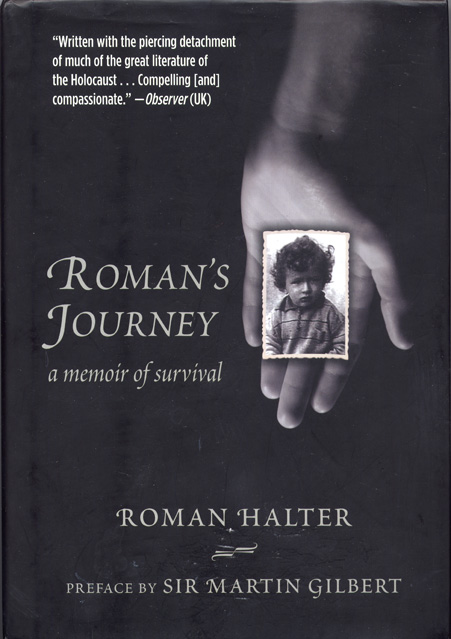 This
is the cover of Roman's memoir. We highly recommend it. It is beautifully and
clearly written and extremely moving.
This
is the cover of Roman's memoir. We highly recommend it. It is beautifully and
clearly written and extremely moving.
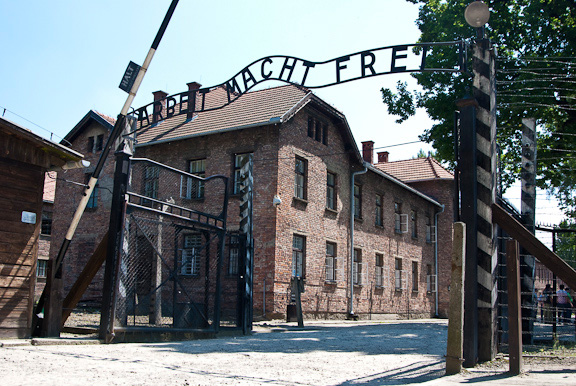 This
is the infamous entry gate to Auschwitz I, the first death camp built by the
Nazis, a few kilometers from the small town of Oswiecim. They chose this
location because of its proximity to multiple railway lines.
This
is the infamous entry gate to Auschwitz I, the first death camp built by the
Nazis, a few kilometers from the small town of Oswiecim. They chose this
location because of its proximity to multiple railway lines.
The words arching over the entrance are German: Arbeit Macht Frei. They mean,
"Work Will Make You Free."
The photo on the left shows how it looks today.
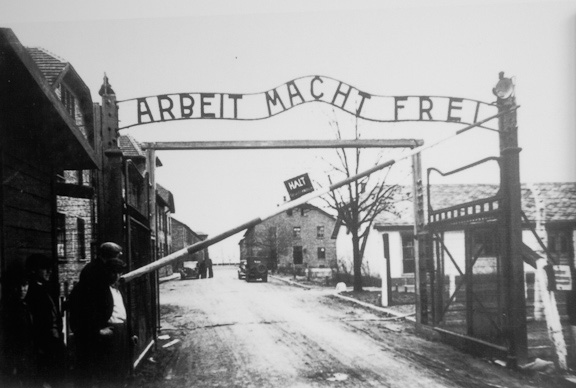 As
you can see from the Nazi-era image on the right, the entrance has hardly changed. Look at the man standing by
the gate on the left in the old photo; it will help you see that the entryway is not so big,
especially when you think of the countless numbers of Nazi victims who passed
through.
As
you can see from the Nazi-era image on the right, the entrance has hardly changed. Look at the man standing by
the gate on the left in the old photo; it will help you see that the entryway is not so big,
especially when you think of the countless numbers of Nazi victims who passed
through.
In this image, note the white building just behind the tree without leaves Ė
perhaps the very same tree in full leaf in our previous photo.
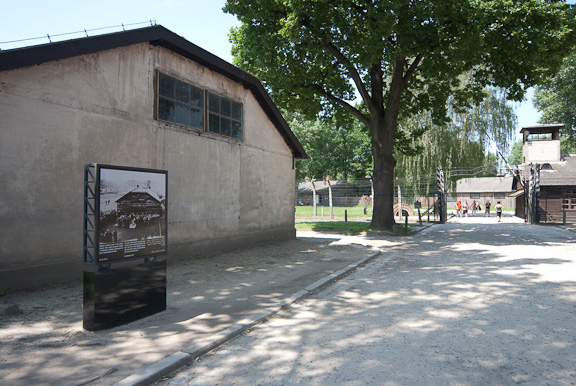 Here
you are looking from the opposite side of the entry road at the same white
building. In that small area beside the building, is where the Jewish prison
orchestra played marches every morning and night as the prisoners doing slave
labor had to keep time as they departed in the early morning and returned many
hours later.
Here
you are looking from the opposite side of the entry road at the same white
building. In that small area beside the building, is where the Jewish prison
orchestra played marches every morning and night as the prisoners doing slave
labor had to keep time as they departed in the early morning and returned many
hours later.
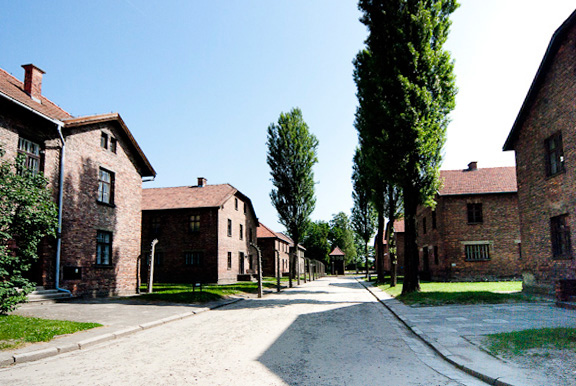
You
are looking down one of the "streets" of Auschwitz I. Notice that the buildings
are all intact. It could be a neighborhood almost anywhere, if not for the
barbed wire and the guardhouse at the end of the street.
The next few images take you closer and closer in to what it would have been
like to be living in that evil place that looks so superficially normal from a
distance.
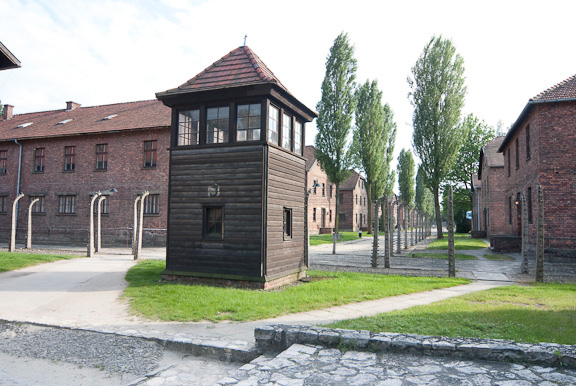
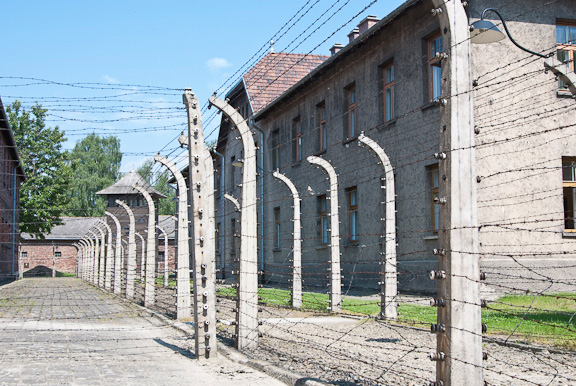
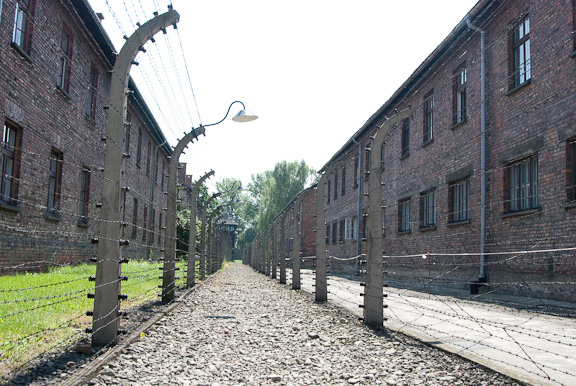
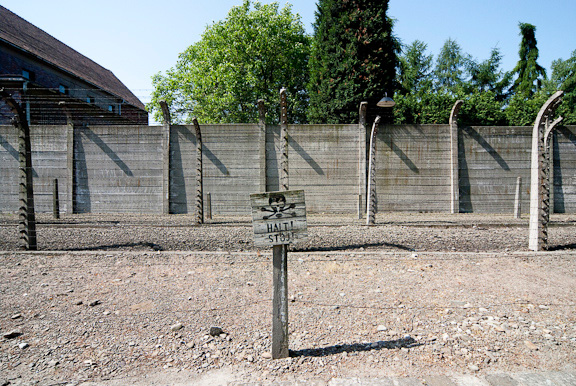
Auschwitz is known primarily as the place where the Nazis "perfected" their
aspiration to create an efficient factory for murdering people. However, in
Auschwitz as everywhere else, they also conducted more formal executions by
other means, designed to intimidate and terrorize the slave laborers -- those who were not immediately sent to the gas chambers
upon arrival.
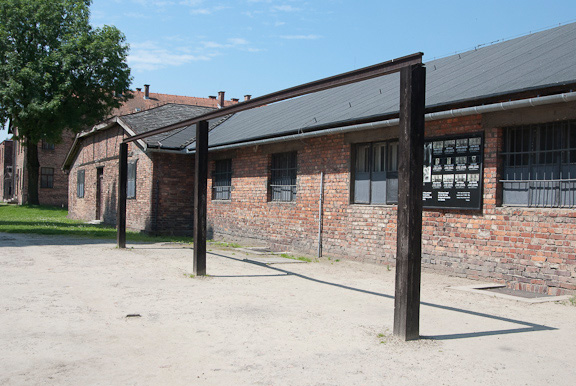 This photo shows the gallows that could accommodate multiple hangings.
This photo shows the gallows that could accommodate multiple hangings.
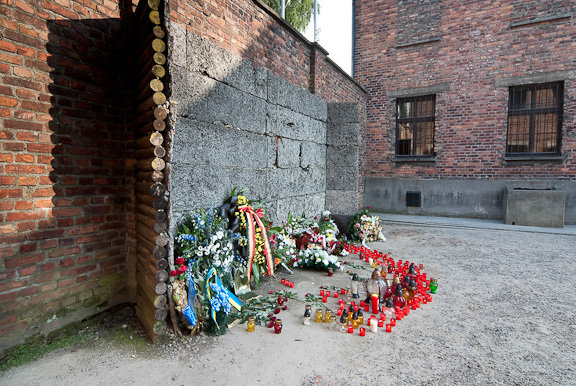 The photo to the right shows the execution wall where prisoners were lined
up and shot.
The photo to the right shows the execution wall where prisoners were lined
up and shot.
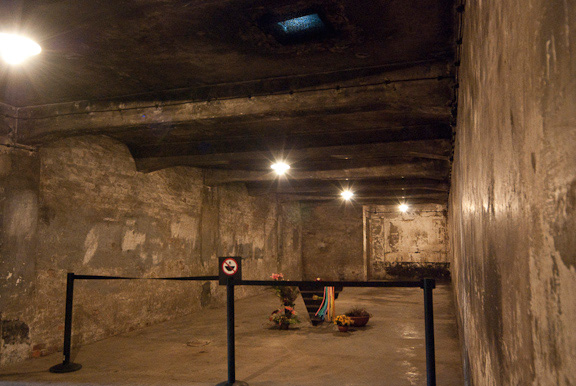 Now you are looking inside the gas chamber. If you look near the top
center, you
can faintly see the square opening in the ceiling (now covered by wood), one of
two where they dropped in the Zyklon B gas that killed by suffocation.
Now you are looking inside the gas chamber. If you look near the top
center, you
can faintly see the square opening in the ceiling (now covered by wood), one of
two where they dropped in the Zyklon B gas that killed by suffocation.
Our group had special permission to move behind the barrier. We were told that
300 people were routinely squeezed into this gas chamber. All 160 of us moved as
close together as we could into the center. This did not begin to approximate
the conditions of an actual execution, but it gave us a tiny glimpse of how it
might have felt at the onset.
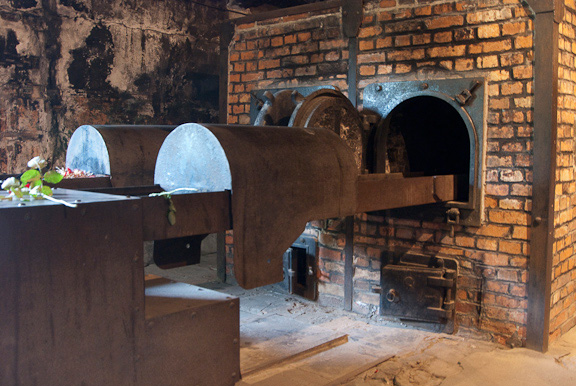 A door on the left side of the gas chamber opened to the crematorium. Just a few
steps to shift the victims' bodies into the furnaces. The bodies were placed on
the metal carts on the left, which rolled on tracks (see foreground), right into
the furnaces. Faith was particularly struck by how narrow were the trays that
held the corpses. She thought about how easily they would have accommodated the
emaciated bodies of people who had already been starving for weeks, months or
years.
A door on the left side of the gas chamber opened to the crematorium. Just a few
steps to shift the victims' bodies into the furnaces. The bodies were placed on
the metal carts on the left, which rolled on tracks (see foreground), right into
the furnaces. Faith was particularly struck by how narrow were the trays that
held the corpses. She thought about how easily they would have accommodated the
emaciated bodies of people who had already been starving for weeks, months or
years.
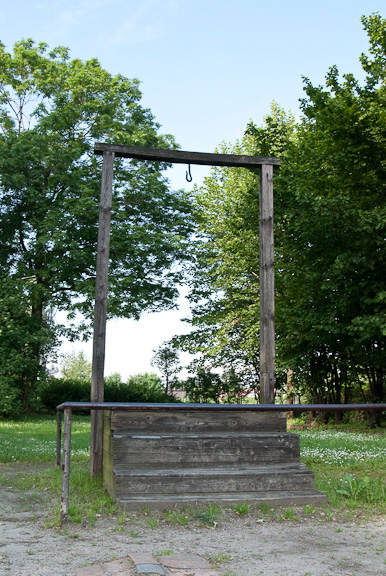 This special gallows stands just outside the gas chamber. This is where the camp
commandant, Rudolf Hoess, was hung after the Nuremberg trials.
This special gallows stands just outside the gas chamber. This is where the camp
commandant, Rudolf Hoess, was hung after the Nuremberg trials.
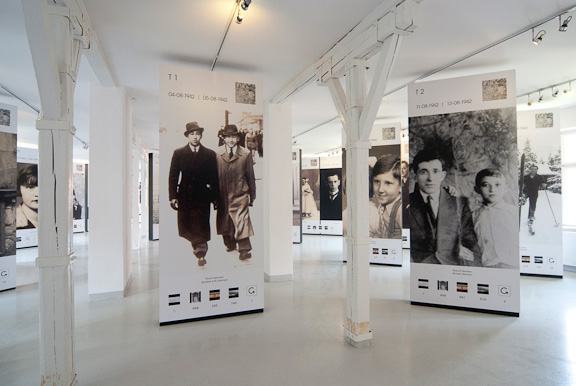 This is our last photo from Auschwitz I. After the war, many of the former
barracks were "adopted" by different governments that wanted to establish small
commemorative museums. This is a room from the Belgian Government exhibit. Each
blown-up photo shows one or two people from a specific transport to the death
camp, with the dates of deportation and extermination at the top. At the bottom,
the second number from the left shows how many were in that particular
transport. The number at the far bottom right shows how many survived; in many
cases, that number is zero.
This is our last photo from Auschwitz I. After the war, many of the former
barracks were "adopted" by different governments that wanted to establish small
commemorative museums. This is a room from the Belgian Government exhibit. Each
blown-up photo shows one or two people from a specific transport to the death
camp, with the dates of deportation and extermination at the top. At the bottom,
the second number from the left shows how many were in that particular
transport. The number at the far bottom right shows how many survived; in many
cases, that number is zero.
Auschwitz I was used primarily to murder Polish political prisoners and others
victimized by the Nazis relatively early in the war. As the Nazis' mass
extermination plans exploded in magnitude, their needs quickly outgrew the
campís capacity. (You can walk from one end of the camp to the other in less
than ten minutes.)
Their solution was to build an enormous new camp about 3 kilometers away --
Auschwitz II, also called Birkenau. Birkenau was built so that a railway line
ran directly into the camp itself, conveniently depositing the cattle cars full
of victims near four large gas chambers/crematoria. Birkenau extends some 430
acres.
The track could easily accommodate a train with 35 cattle cars, the number in
the transport that carried Faith's cousin Roman and others from the liquidated
Lodz ghetto to Auschwitz.
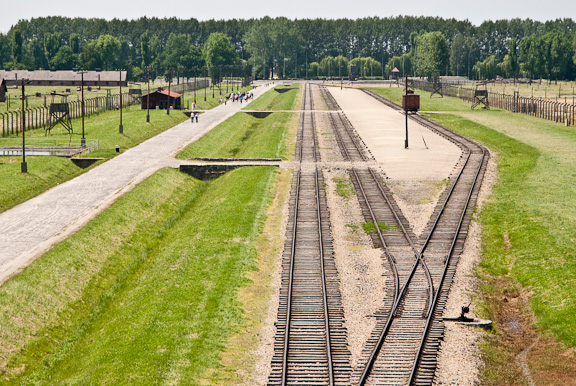 This first photo from Birkenau shows the tracks with switching points, which
facilitated trains arriving and departing around the clock. The pathway on the
left where visitors are walking is where the cars were emptied and the
"selections" took place. This is where Dr. Mengele and his staff quickly scanned
the new arrivals who had not died en route, pointing one way for those being
sent directly to the gas chamber and another way for the relatively few deemed
sufficiently fit to serve as slave labor.
This first photo from Birkenau shows the tracks with switching points, which
facilitated trains arriving and departing around the clock. The pathway on the
left where visitors are walking is where the cars were emptied and the
"selections" took place. This is where Dr. Mengele and his staff quickly scanned
the new arrivals who had not died en route, pointing one way for those being
sent directly to the gas chamber and another way for the relatively few deemed
sufficiently fit to serve as slave labor.
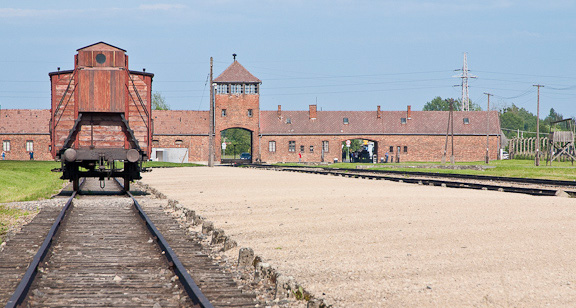 Here we are looking back down the track, towards the entrance to Birkenau.
Under the watchtower is the rail entrance, and to the right is the entrance for people
and other vehicles. The train sitting on the track is a restored smaller-size car that was
used for transporting Hungarian Jews late in the war.
Here we are looking back down the track, towards the entrance to Birkenau.
Under the watchtower is the rail entrance, and to the right is the entrance for people
and other vehicles. The train sitting on the track is a restored smaller-size car that was
used for transporting Hungarian Jews late in the war.
The next two photos show chaotic scenes of victims being unloaded and lined up
for "selection." You can see the
modern-day site to the side of the display photos.
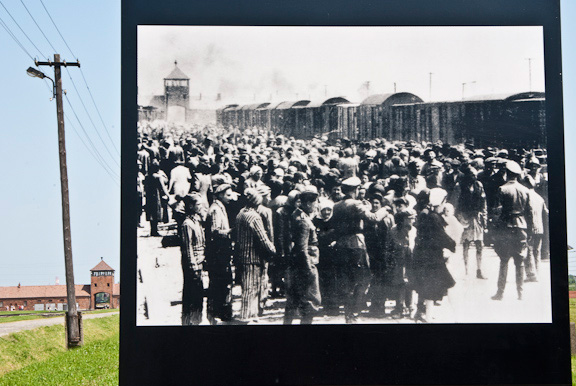
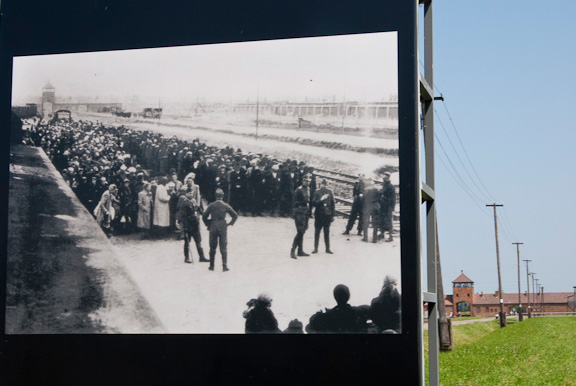
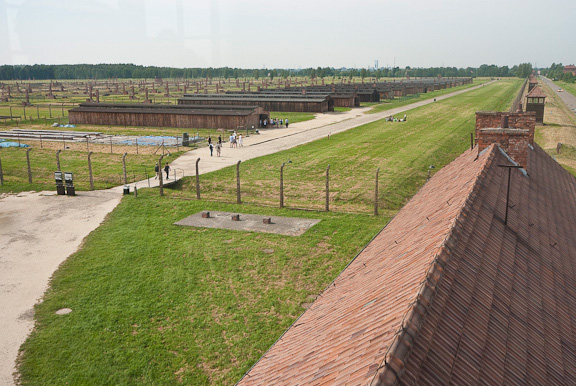 This
is a shot from the watchtower built over the rail entrance. You can see that
some barracks remain intact today. However, for most of the site, which extends
far out ahead, left and right, nothing remains of the barracks except the
chimneys.
This
is a shot from the watchtower built over the rail entrance. You can see that
some barracks remain intact today. However, for most of the site, which extends
far out ahead, left and right, nothing remains of the barracks except the
chimneys.
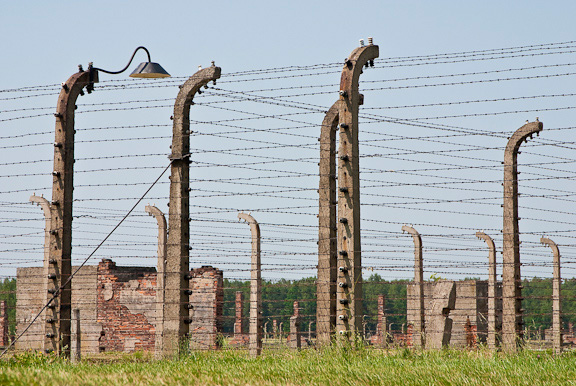 On
the other hand, most of the barbed wire -- which was all electrified at the time
-- is still intact. Birkenau was enormous; it was
divided into sub-camps delineated by paths lined by barbed wire and steep
V-shaped ditches, which remain. There are also steep V-shaped ditches on either
side of the rail tracks.
On
the other hand, most of the barbed wire -- which was all electrified at the time
-- is still intact. Birkenau was enormous; it was
divided into sub-camps delineated by paths lined by barbed wire and steep
V-shaped ditches, which remain. There are also steep V-shaped ditches on either
side of the rail tracks.
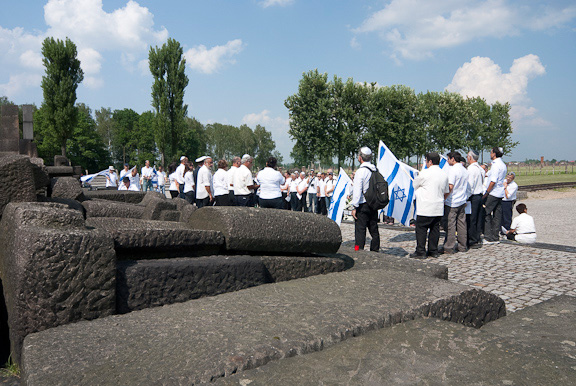 A peace plaza built after the war lies a short distance beyond the end of the
rail tracks. This is a memorial ceremony being conducted by an Israeli security
force that laid a wreath on behalf of the Office of the President of Israel.
A peace plaza built after the war lies a short distance beyond the end of the
rail tracks. This is a memorial ceremony being conducted by an Israeli security
force that laid a wreath on behalf of the Office of the President of Israel.
Initially there were two crematoria at Birkenau, one on each side of the end of
the tracks. These were numbers 2 and 3 (number 1 was the Auschwitz I
crematorium). The Nazis later added two more crematoria at Birkenau, for a total
of five at the Auschwitz-Birkenau camps.
As the Allied forces drew near at the end of the war, the SS blew up three of
the four crematoria at Birkenau, in a ludicrous attempt to destroy the evidence
of their war crimes. The fourth had been blown up shortly before by Jewish
prisoners, a revolt that raised spirits throughout the camp but also resulted in
severe reprisals and eventual capture and death of those who carried out the
revolt. One woman, who smuggled explosives from her job as a slave laborer, was hung before all the inmates at Auschwitz I in a scene that is
recounted in many of the books written by camp survivors.
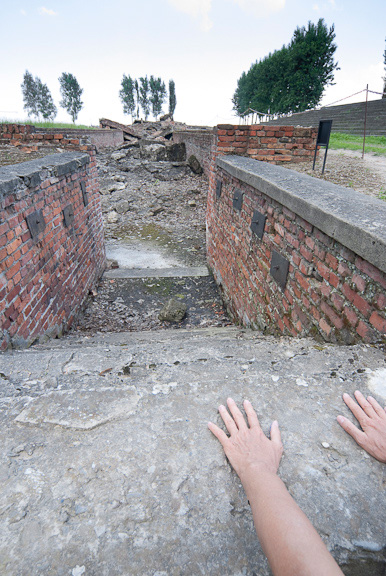 In this image, we are looking at the remains of the steps down which prisoners
were herded into the gas chamber of Birkenau crematorium #2.
In this image, we are looking at the remains of the steps down which prisoners
were herded into the gas chamber of Birkenau crematorium #2.
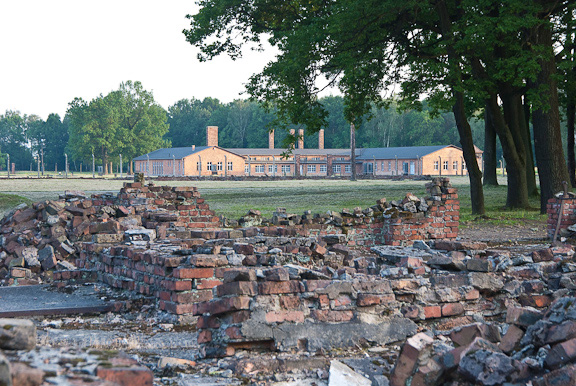 Here we are looking from the back of crematorium #4, the one blown up by Jewish
prisoners, towards the "bathhouse" or "sauna." This is the building where transportees destined for slave labor were deprived of all their clothes and any
remaining belongings, disinfected, shaved, tattooed, and given ill-fitting,
flimsy striped prison garb.
Here we are looking from the back of crematorium #4, the one blown up by Jewish
prisoners, towards the "bathhouse" or "sauna." This is the building where transportees destined for slave labor were deprived of all their clothes and any
remaining belongings, disinfected, shaved, tattooed, and given ill-fitting,
flimsy striped prison garb.
Birkenau, besides being the main death camp, was also a major transit station
for moving around prisoners, especially towards the end of the war when the
Nazis began shifting concentration camp populations as the Allied forces
advanced. Some of the people who passed through the "bathhouse" ended up at
other camps. This was the experience of Roman, who spent ten days in "quarantine" at Auschwitz before being sent on to the Stutthof concentration
camp (where it was a relief to find "only" one crematorium), and then later to
slave labor in Dresden, shortly before the city was firebombed.
It was standard practice to "quarantine" new arrivals selected for slave labor.
They were confined for about two weeks to barracks run by the most sadistic
guards in the camp, for the express purpose of breaking their spirits and
indoctrinating them to obey all rules and procedures. Anyone who became sick or
otherwise broke down under the virtually constant brutality and torture was sent
to the "infirmary." Few returned from the "quarantine infirmary." Most were sent
to the gas chamber.
Just beyond the remains of crematorium #4 lie three ponds. These were ash pits
for disposal of what remained after burning the bodies of those who were gassed
or were killed by other means (hanging, shooting, beating, starvation, illness,
medical experiments, work injuries, etc.). There was also an open area nearby
for burning additional bodies at times when the crematoria were already
operating at full capacity.
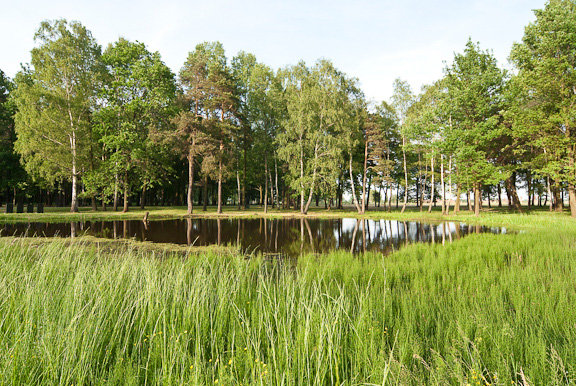 This is a photo of the largest of the ponds that were formerly ash pits. Such
deceptive beauty.
This is a photo of the largest of the ponds that were formerly ash pits. Such
deceptive beauty.
This pond/ash pit is one of many, many places all around Birkenau where we said
Kaddish, the Jewish prayer of mourning for the dead. This is how we spent most
of our time at Birkenau on our own, after the first day of touring both camps
with our group.
We said Kaddish dozens and dozens of times, for family members, for friends and
their families, for all the souls known and unknown of those who suffered
persecution and, in most cases, extermination. Each time we recited Kaddish for
a specific person, we first spoke to that person as if he or she were present,
sharing whatever memories, stories or background information we had.
The Kaddish prays that "the Great Name whose Desire gave birth to the Universe .
. . [will] rule your life and your day and all lives of our World." It ends with
a wish for peace. (This quote is from the English translation used by the Zen
Peacemakers. The group also recited translations in Polish and German.)
The next three photos are of a barrack where Faith and Ralph received permission to spend the
entire night alone. This was an offshoot of the special practices and access of
the Zen Peacemakers group. During each retreat, they spend part of one evening
holding a vigil for the dead in one of the barracks. We made special arrangements
to stay by ourselves in a barrack near where the main group met.
We spent the night in one of the original barracks, which were built to hold 52
horses each. Instead, they were converted to housing for prisoners, with tiered
bunk beds crammed together. Four to eight prisoners typically shared a single
tier of each bunk, living in unimaginably horrible conditions. Sanitation was
essentially non-existent and all sorts of infestations, infections and diseases
were rampant.
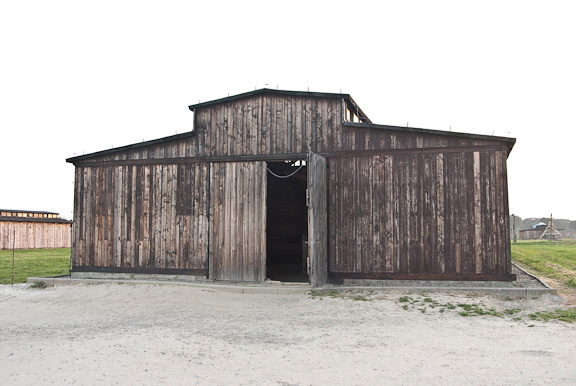
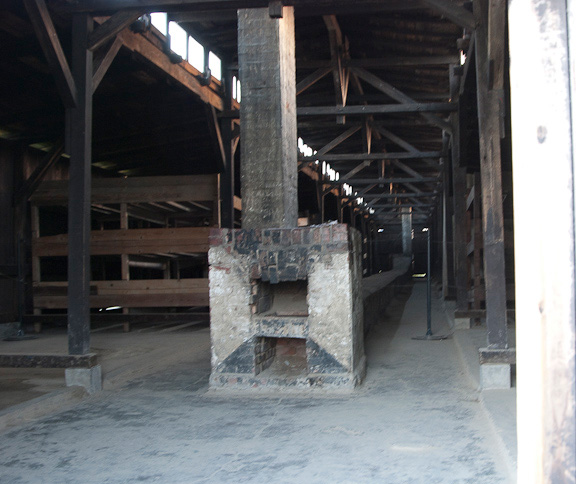
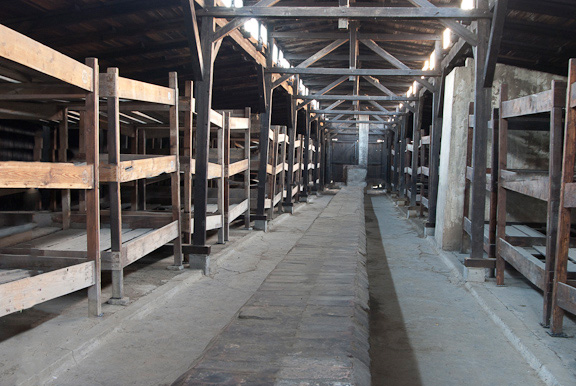
Our vigil began at 7:00 p.m. We sat behind the barracks while the sun set and
there was still enough light to read. We took turns reading from the section of
Romanís book that describes his experiences from the time when the Nazis
liquidated the ghetto in Lodz, Poland where he, his parents, grandfather and a
few other family members lived in dire circumstances for years, up through the time when he was imprisoned
at Auschwitz. Roman's father, grandfather and nephew died in the ghetto. His
remaining close family members were subsequently murdered in concentration
camps.
As it became dark, we moved inside. We sat for a long time, feeling the energy
of the space and waiting for it to become more quiet as the majority of our
group left in two shifts, at 9:00 and midnight.
It was pitch black inside. As we focused on the space, we both began to feel
more strongly the evil of this terrible place, and the unimaginable suffering
that happened there over several years. We discussed whether we were simply
projecting onto our experience what we already knew, but both of us felt
strongly that our feelings were real.
This was confirmed when we reached beyond the chains cutting off access to the
main part of the barrack and touched the three-tiered bunk beds. The feelings of
awfulness became incredibly magnified, more than words can explain. It was
terrifying, especially for Faith, who felt as if she really were a prisoner in
the camp. This sense was intensified by the constant coming and going of nearby
trains all through the night, with us imagining that each one was bringing another
transport.
It felt like we were truly in Hell. We followed our meditation practices of
following our breath, tracing sensations in our bodies, feeling the ground
beneath us, doing our best to stay present to our experience and being a support
to each other (mostly Ralph supporting Faith, who was feeling much more intense
fear and anguish). We spent much of the time sitting with our backs to the side
of the chimney that you can see in the front of the interior.
After many hours, Faith began to feel a different kind of energy, coming from a
bunk bed farther down the row beyond the chains. It carried a clear sense of
determination, courage and calm. Someone passed through this awful place whose
energy was so strong, powerful and positive that it left a mark that was clearly
perceptible to her. This was a great comfort to both of us. It helped us to sit
with calmer, more open hearts for the remaining hours till dawn.
As it slowly became light, we recited Kaddish and also Buddhist prayers for the
souls of all who suffered, starting from the barrack where we were, and
spreading out into larger and larger rings. After the sun was fully up, we read
together some passages from Romanís book about his will to live, and also his
beloved grandfatherís favorite prayer.
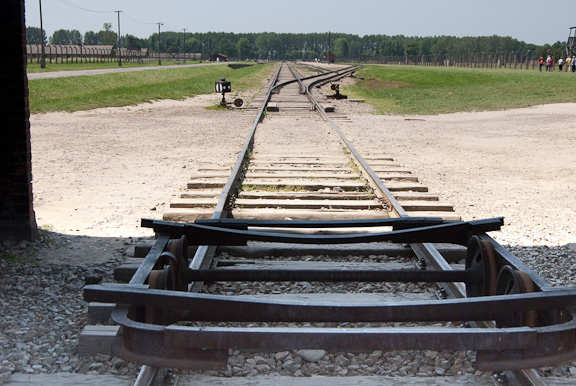 This last photo of the track shows where we ended our visit to Auschwitz-Birkenau.
The shadow is because we were sitting where the track first enters Birkenau,
beneath the main guardhouse. We said our final Kaddishes here. Then, as we left
the camp, we stood at the entrance facing outward, and recited one last Kaddish
and Buddhist prayer for all people through all time who have suffered from war
and brutality, along with our wishes for peace.
This last photo of the track shows where we ended our visit to Auschwitz-Birkenau.
The shadow is because we were sitting where the track first enters Birkenau,
beneath the main guardhouse. We said our final Kaddishes here. Then, as we left
the camp, we stood at the entrance facing outward, and recited one last Kaddish
and Buddhist prayer for all people through all time who have suffered from war
and brutality, along with our wishes for peace.
Back in Krakow, which is about 35 miles from Auschwitz-Birkenau, we took a
couple of days to reflect on our experience and visit places important to local
Jewish history.
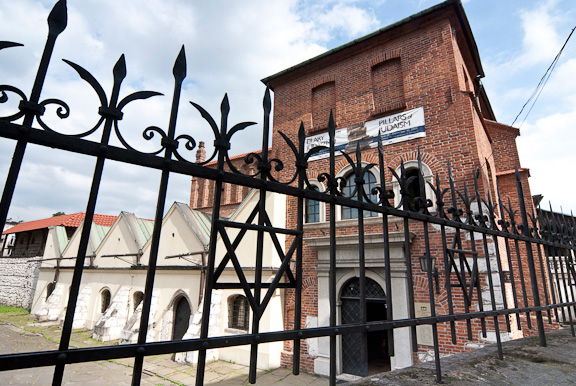 This is the first synagogue of seven that were built in the Jewish district of
Krakow, the Kazimierz. Notice that it was built below ground level. That was
partly in obedience to a law requiring that no Jewish building be as high as any
church and also to avoid appearing in any way ostentatious to the non-Jewish
population. The original building (right side) was constructed in the early 15th
century.
This is the first synagogue of seven that were built in the Jewish district of
Krakow, the Kazimierz. Notice that it was built below ground level. That was
partly in obedience to a law requiring that no Jewish building be as high as any
church and also to avoid appearing in any way ostentatious to the non-Jewish
population. The original building (right side) was constructed in the early 15th
century.
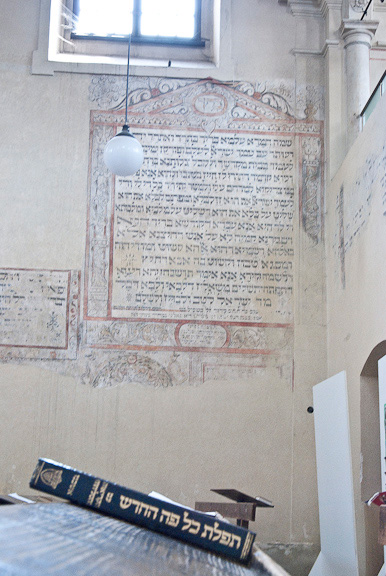 This is the
Izaak Jakubowicz Synagogue. Its members were too poor to own Siddurs (prayer books)
and so the major Hebrew prayers were painted on its walls. The Nazis painted
over the prayers when they converted the synagogue to other uses, but part of
the underlying script has been restored. There is a contemporary Siddur in the
foreground of the photo.
This is the
Izaak Jakubowicz Synagogue. Its members were too poor to own Siddurs (prayer books)
and so the major Hebrew prayers were painted on its walls. The Nazis painted
over the prayers when they converted the synagogue to other uses, but part of
the underlying script has been restored. There is a contemporary Siddur in the
foreground of the photo.
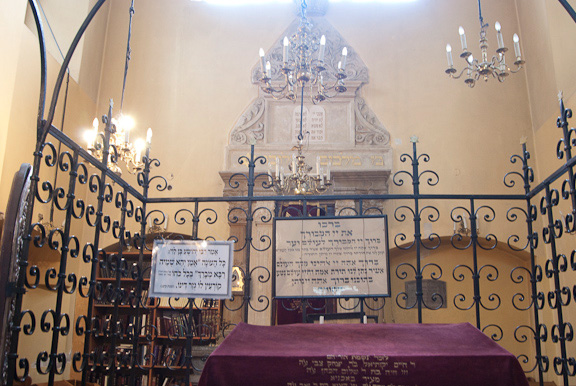 Here is
the 16th-century "New" Synagogue, one of a few private synagogues, built by a wealthy family. The Nazis
stripped all of Krakow's synagogues of their original furnishings and they have
been refurbished with materials from synagogues in outlying districts. However,
the Nazis did not bother to destroy stonework, and so the carved ark in the
background is original, with the decoration restored after the war.
Here is
the 16th-century "New" Synagogue, one of a few private synagogues, built by a wealthy family. The Nazis
stripped all of Krakow's synagogues of their original furnishings and they have
been refurbished with materials from synagogues in outlying districts. However,
the Nazis did not bother to destroy stonework, and so the carved ark in the
background is original, with the decoration restored after the war.
Much of the restoration of the Kazimierz District occurred after the film
Schindlerís List was released. Part of it was filmed here. The film generated a
massive rejuvenation. Kazimierz is now a major tourist destination, with
original buildings that have been carefully renovated, restaurants that sell
Jewish-style food, and a
Jewish bookstore (called Jarden) that organizes tours.
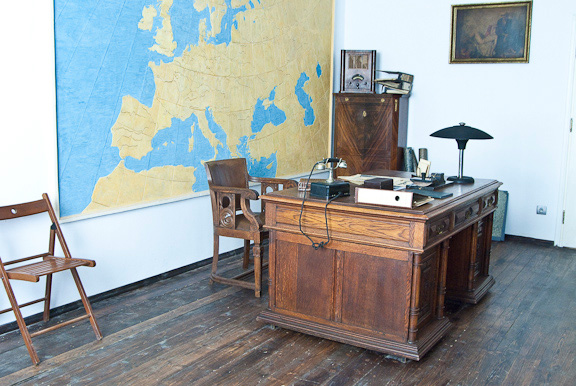 The Schindler factory is located a short walk from the Kazimierz, on the other
side of the Wisla River. It has been converted to a museum that documents the
Nazi occupation of Krakow. This is a photo of Schindlerís desk.
The Schindler factory is located a short walk from the Kazimierz, on the other
side of the Wisla River. It has been converted to a museum that documents the
Nazi occupation of Krakow. This is a photo of Schindlerís desk.
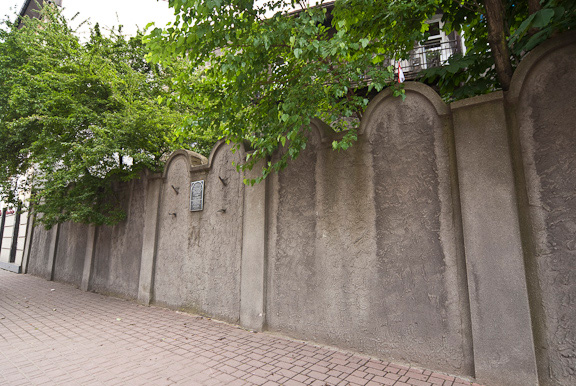 As one passes through the museum exhibits, they gradually turn to the plight of
Krakowís Jewish population as the Nazis herded them into a ghetto adjacent to
the main railway station. The Nazis took great pains to design the ghetto in
ways that would promote at every level a sense of hopelessness and despair. For
example, the walls were shaped to resemble headstones and also to mock the shape
of the tablets of the Ten Commandments. This is a photo of the only fragment of
the ghetto wall that remains; it was necessary to remove the walls in order to
restore the area to livability after the war.
As one passes through the museum exhibits, they gradually turn to the plight of
Krakowís Jewish population as the Nazis herded them into a ghetto adjacent to
the main railway station. The Nazis took great pains to design the ghetto in
ways that would promote at every level a sense of hopelessness and despair. For
example, the walls were shaped to resemble headstones and also to mock the shape
of the tablets of the Ten Commandments. This is a photo of the only fragment of
the ghetto wall that remains; it was necessary to remove the walls in order to
restore the area to livability after the war.
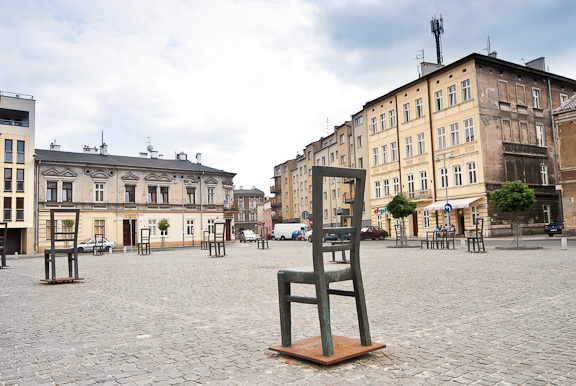 This next photo shows the square where the early deportations from the ghetto to
concentration camps occurred. The chairs are a memorial, reminders of all that
was stolen from the Jewish population, including their lives and their culture.
The ghetto was only a few square blocks in size. At the peak of overcrowding,
approximately 16,000 people were crammed into only 320 buildings including those that appear behind the plaza.
This next photo shows the square where the early deportations from the ghetto to
concentration camps occurred. The chairs are a memorial, reminders of all that
was stolen from the Jewish population, including their lives and their culture.
The ghetto was only a few square blocks in size. At the peak of overcrowding,
approximately 16,000 people were crammed into only 320 buildings including those that appear behind the plaza.
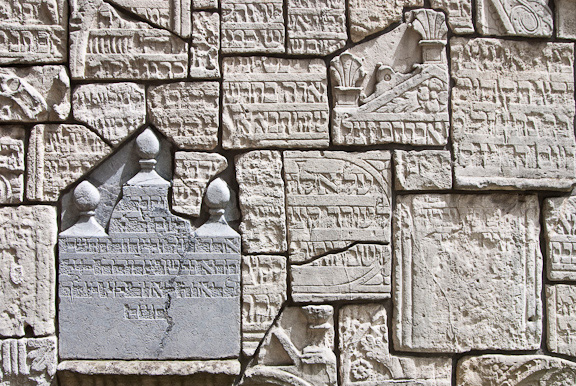 Another Nazi ploy to demoralize the Jews was to break up headstones from the
Jewish cemeteries and use them for street paving. The Jews who went outside the
ghetto for slave labor walked each day over these broken tombstone fragments; this
appears in a scene in Schindlerís List.
Another Nazi ploy to demoralize the Jews was to break up headstones from the
Jewish cemeteries and use them for street paving. The Jews who went outside the
ghetto for slave labor walked each day over these broken tombstone fragments; this
appears in a scene in Schindlerís List.
After the war, these desecrations were pried off the streets and the broken
tombstones were used to rebuild the interior walls of the old cemetery in
Kazimierz. You can see a small section of reconstructed cemetery wall in this
photo. This wall is sometimes referred to as the "Wailing Wall," reminiscent of
the Western ("Wailing") Wall in Jerusalem. As in Jerusalem, religious
supplicants write prayers and requests on small pieces of paper and leave them
in crevices.
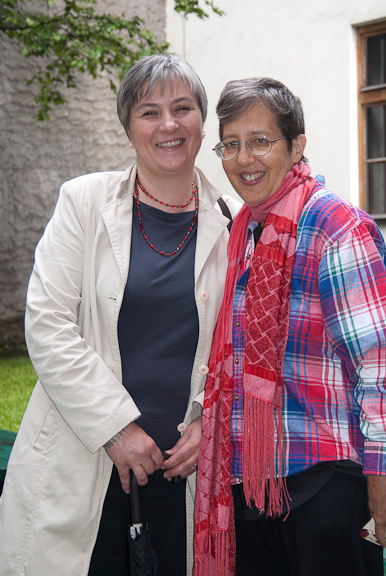 We chose to end our visit and this photo-journal on a positive note. This photo
shows Faith with Lucyna ("Lucy") Les, owner of the Jewish bookstore (Jarden),
standing together outside the Krakow City Archives.
We chose to end our visit and this photo-journal on a positive note. This photo
shows Faith with Lucyna ("Lucy") Les, owner of the Jewish bookstore (Jarden),
standing together outside the Krakow City Archives.
At the beginning of our trip, we had gone to the bookstore to inquire about
obtaining archival information. This was because Faithís friend David had asked
her to see if she could get any information about his great-grandfather for whom
he is named. David only knew that his great-grandfather was in Krakow during
World War II.
Lucy immediately offered to accompany us to the Archives, since no one there
speaks much English. Moreover, she did extensive computer research while we were
at Auschwitz-Birkenau to track down information about Davidís family.
We went to the archives well-prepared and triumphantly emerged two hours later
with a receipt confirming that Faith would shortly receive a CD with copies of
all the documents we requested from the Krakow city census of 1900 and 1921, and
the Nazi records from the ghetto -- including David's great-grandfather's
identity card with his photograph.
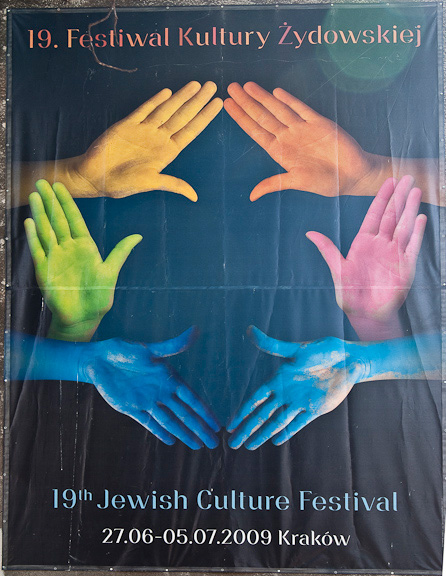 Our last photo is a poster for Krakowís 19th Jewish Culture Festival, which took
place in July 2009. (We liked the poster better than the one for this yearís
20th festival.)
Our last photo is a poster for Krakowís 19th Jewish Culture Festival, which took
place in July 2009. (We liked the poster better than the one for this yearís
20th festival.)
One of the remarkable aspects about the resurgence of interest in Jewish culture
in Krakow is that it rests almost entirely on the efforts of Gentiles, mostly
Roman Catholics Ė including Lucy. There are virtually no younger Jews in Krakow.
The only ones who have not emigrated are Holocaust survivors and some of their
children.
Nevertheless, there is a vibrant, genuine interest and love for Jewish culture
and knowledge, as evidenced by activities like the Jewish Culture Festival and
Jewish Studies programs in local universities. In fact, our delightful tour
guide in Krakow, Paulina Fiejdasz, is a filmmaker who specializes in Jewish
topics.
This is the end of our photo-journal but of course, it is not the end of our
experience. We created this less than a week after our return to help us begin
to make sense of our thoughts and feelings while they were still raw and fresh.
Also, we hope that this will convey to you, our family and friends, at least a
small glimpse of what that experience was like.
No amount of reading, or watching movies and documentaries, or talking with
Holocaust survivors, or anything else, could prepare one adequately for the
reality we encountered. You cannot understand the enormous scale of Auschwitz-Birkenau
unless you see it. You canít fully grasp (not that we could, even being there)
how horrifically and efficiently they operated as factories for murdering
millions of innocent people. You canít really feel the evil and the suffering
without walking the ground where it occurred.
It was a wrenching, horrible, exhausting and yet very rewarding trip. For Faith,
it was an incredible chance to squarely face her deepest fears. For Ralph, it
made vivid the many allusions and stories he heard, growing up with parents and
grandparents who barely escaped with their lives from Germany after
Kristallnacht.
We are both so grateful for having had the opportunity to do this and do it
together. Our connection to Faith's cousins, Roman and Susie, amplified both the pain and the
fullness of our experience.
Thank you for taking the time and effort to read this.
 This
is the cover of Roman's memoir. We highly recommend it. It is beautifully and
clearly written and extremely moving.
This
is the cover of Roman's memoir. We highly recommend it. It is beautifully and
clearly written and extremely moving.



































